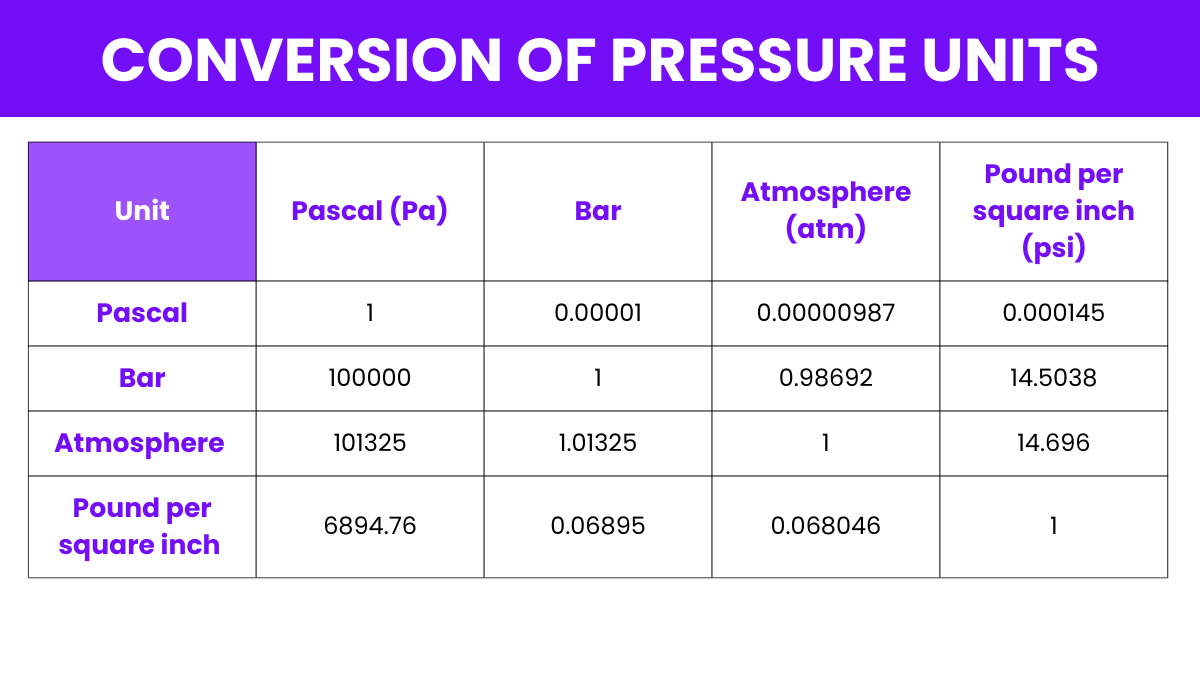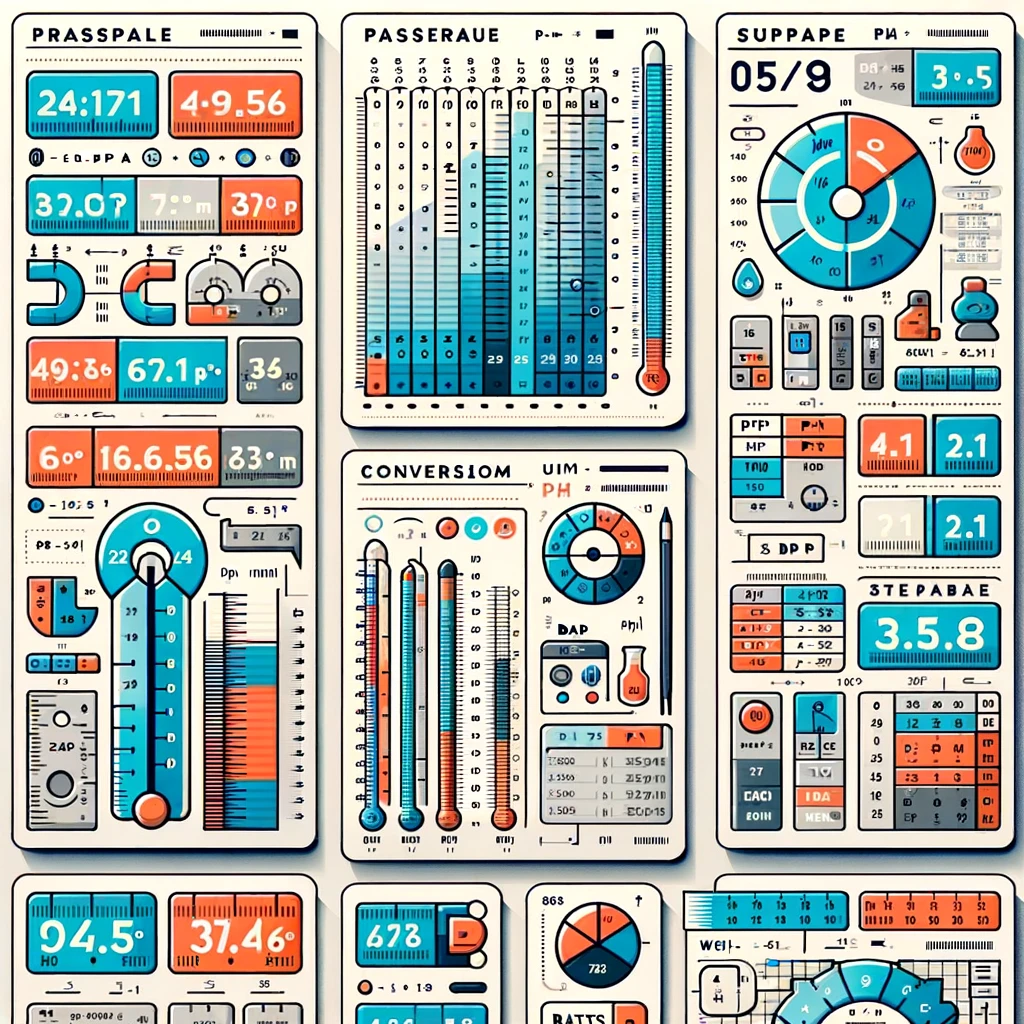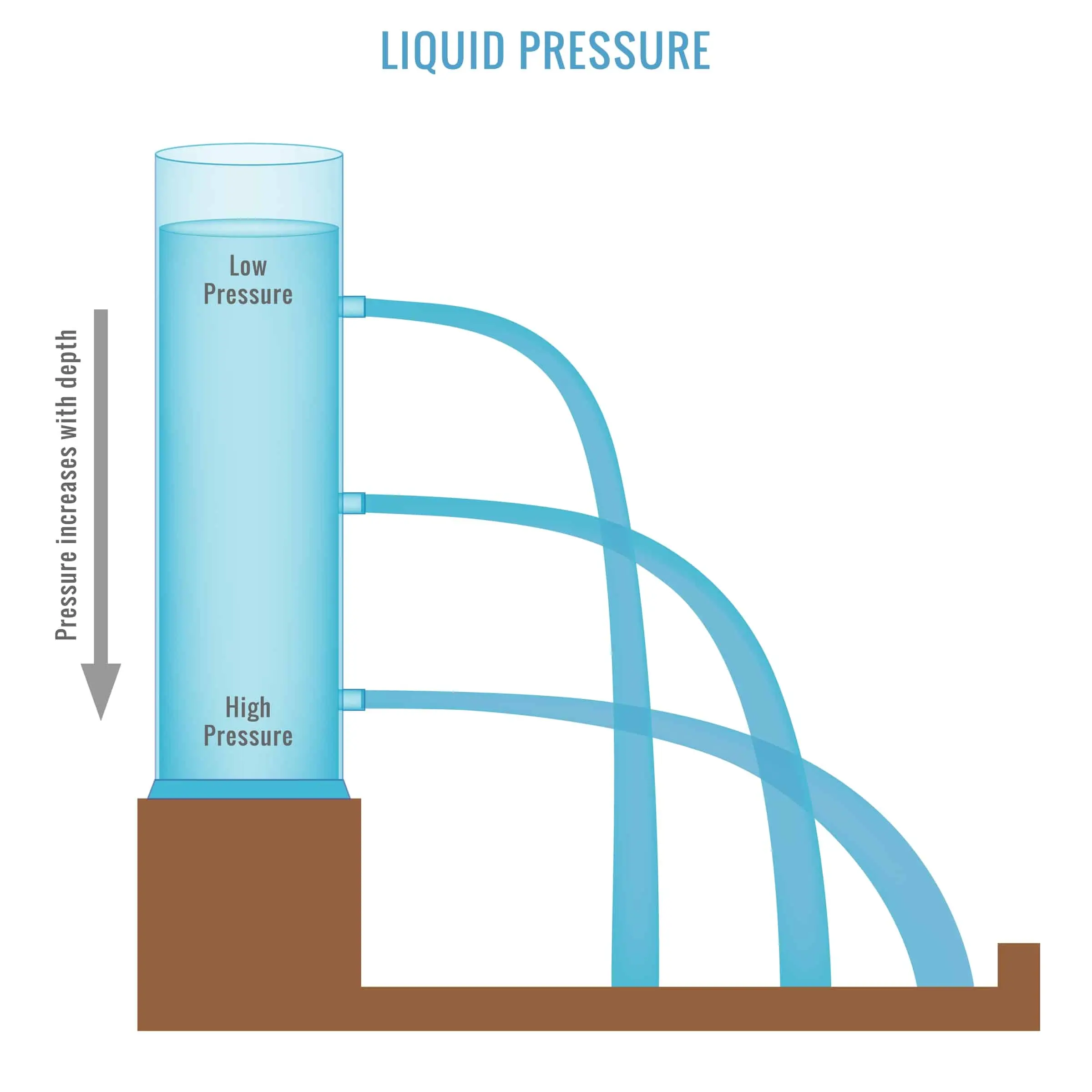Pressure Converter
The Pressure Converter tool allows you to convert between different units of pressure, such as pascals, bar, psi, and more, providing accurate and instant results. This tool is perfect for engineers, scientists, students, and anyone who needs to convert pressure measurements for various applications. The process is simple and efficient, ensuring precise conversions every time.
Share on Social Media:
Effortless Pressure Unit Conversion: Your Ultimate Guide to Using a Pressure Converter
In urgent need of a pressure unit transformation? Our concise guide equips you with the know-how to utilize a pressure converter effectively. Step into the world of unit conversion with confidence as we demystify Pascals, PSI, atmospheres, and bars, geared towards accurate and straightforward application.
Key Takeaways
PagesTools.com offers an easy-to-use Pressure Converter tool that helps professionals and students perform pressure unit conversions, providing a seamless user experience and clear results display.
The understanding of different pressure units and their conversions is essential for a wide range of professional fields, as it ensures precision and safety in tasks such as calibrating equipment or maintaining structural integrity in various applications.
Advanced techniques for pressure conversion, such as utilizing mnemonic devices, visual aids, downloadable charts, and interactive nomograms, can enhance accuracy and efficiency, while also considering factors like temperature variations and altitude differences.
Mastering the Pressure Converter on PagesTools.com

Delving into the digital realm, PagesTools.com emerges as a beacon for professionals and students alike, offering a Pressure Converter tool that epitomizes simplicity and efficiency. Whether you’re a seasoned engineer or a curious student, mastering this tool will enhance your ability to navigate the complexities of pressure units.
The converter’s user-friendly design allows even newcomers to pressure conversion to perform conversions confidently and precisely.
Entering Your Data
The initial step in your conversion journey involves entering the pressure value you wish to transform. PagesTools.com’s converter is designed with a clear input field for the source value, ready to accept any numerical data you provide, be it typed or pasted from an external source.
This focus on user convenience emphasizes the platform’s dedication to a seamless experience, helping you concentrate on the results rather than the process.
Selecting Units for Conversion
As the next step unfolds, you’ll find yourself amidst a sea of other pressure units from which to choose. A dropdown menu presents a wide range of options, including:
atmospheres
inches of mercury
pascals
pounds per square inch
The selection process is enhanced by shortcut buttons, providing a rapid route to commonly used units, saving you time and streamlining your conversion journey.
Obtaining Conversion Results
Once your data is entered and units are selected, the magic happens. With a mere click, the pressure conversion calculator displays your results in an output box, a testament to the converter’s efficiency.
The lower answer box displays the converted pressure values, clear and ready for use, allowing your project to proceed smoothly.
Understanding Pressure Units and Their Importance

The tapestry of pressure units is rich and intricate, woven into the fabric of numerous fields that shape our world. From the Pascal, the SI unit of pressure, to the familiar pounds per square inch, each unit serves a unique purpose and adheres to specific contexts. Understanding these units’ significance goes beyond academia; it’s a vital skill for ensuring precision and safety in tasks like calibrating sensitive equipment or maintaining structural integrity.
The Fundamentals of Pressure Measurement
Pressure measurement is the cornerstone of countless processes, from the flow of gases to the stability of liquids, each relying on the precise quantification of force over area. Hydrostatic pressure, for instance, reveals the weight of fluid exerted due to gravity’s pull and is pivotal in medical, engineering, and scientific applications.
When blood pressure reads in millimeters of mercury, or when an engineer calculates the force on a dam wall, the right pressure conversion table becomes an indispensable tool, bridging different measurement systems with ease.
Diverse Applications of Different Pressure Units
Pressure units, like the versatile tools in an artisan’s kit, find their utility in a vast array of applications. In the realm of chemistry, conversions are the key to unlocking the mysteries of gas laws, while in engineering, they inform the design of sturdy structures and reliable sensors. This versatility is not limited to a handful of fields; it spans across industries, affirming that a deep comprehension of how to translate one unit to another is more than a skill—it’s a necessity.
Comprehensive Guide to Pressure Unit Conversion
Navigating the sea of pressure units, including square centimeter and square foot, may appear daunting, but with the right knowledge, it becomes a harmonious journey across different scales of measurement. From the precise Pascal to the robust pounds per square inch, understanding how to interconvert these units is an invaluable skill in the scientific and engineering domains.
Whether you are referencing a conversion table or applying a specific formula, the ability to fluidly move between units like atm, bar, mmHg, and even kg cm can make all the difference in your calculations. Using a convert bar tool can help you achieve this with ease, even when dealing with hg inches or square meter conversions.
From Psi to Pascal: A Closer Look
The conversion from psi to Pascal (Pa) stands as a testament to the interconnectedness of pressure units within the SI system. A single psi, a measure often encountered in the tire pressure of cars, is equivalent to a substantial 6,894.76 pascal Pa, revealing the dramatic differences that can exist between units.
For instance, converting 5 psi to Pascal is not simply a matter of changing labels; it requires multiplying by 6894.75729 to arrive at the precise equivalent in the SI system—34,473.78645 Pa, to be exact. Such conversions are not just academic exercises but are essential for ensuring compliance with international standards and maintaining uniformity in measurements.
Converting Atmospheric Pressure to Other Units
Atmospheric pressure, the invisible force we live under, is a universal measure that often needs translation into more granular units like bars or millimeters of mercury. One standard atmosphere, the pressure exerted by the weight of air at sea level, can be converted to 1.01325 bars or a more tangible 760 mmHg, enabling a broader understanding of pressure across different contexts.
Such conversions are not just numerical games; they are practical tools that allow scientists to communicate findings and engineers to design systems that perform optimally at various altitudes.
Advanced Tips for Accurate Pressure Conversion
Beyond the basics lies a realm of advanced techniques that offer precision and speed in pressure conversion. Some of these techniques include:
Identifying patterns in conversion formulas
Creating mnemonic devices to aid in memorization
Using visual aids or diagrams to understand the relationships between different units of pressure
By utilizing these advanced techniques, the process of converting pressure units can become a simple recollection exercise, akin to remembering a friend’s phone number.
These methods, alongside practical tools like cheat sheets, pave the way for quick mental calculations, ensuring that you remain nimble and efficient in your work.
Considering Temperature Variations
Temperature, the unseen variable, holds sway over pressure measurements, dictating the behavior of gases as they expand and contract with the ebb and flow of thermal energy. The direct proportionality between gas pressure and temperature, as described by Charles’s Law, is a fundamental principle that must be accounted for when making pressure conversions, especially when the temperature is a fluctuating factor.
Numerous practical examples exist, like oxygen tanks in medical settings or vehicle tires, where a simple 10 degrees Fahrenheit shift can cause a 1 psi pressure change—highlighting the importance of this relationship.
Accounting for Altitude Differences
The ascent to higher altitudes brings with it a drop in barometric pressure, a variable that can significantly impact pressure readings and conversions. Whether you are a pilot navigating the skies or an adventurer scaling a mountain, understanding how to adjust for altitude is crucial in ensuring accurate pressure measurements.
Altitude’s effect on pressure extends beyond theory into practicality, necessitating calculation adjustments to ensure accuracy, as shown by the formula connecting pressure altitude, altimeter settings, and elevation.
Visual Aids for Pressure Conversion

In the age of visualization, visual aids have emerged as powerful allies in the process of pressure conversion. Downloadable charts, with their array of conversion factors laid out in a clear and accessible manner, provide a quick reference for those in need of a swift unit change. The inclusion of interactive nomograms adds an intuitive element to conversions, providing a dynamic and user-friendly alternative for those drawn to a more visual approach in their calculations.
Downloadable Conversion Charts
The world of pressure conversion is vast, but downloadable charts serve as a compass, guiding users through the maze of units with ease. These charts, readily available in both digital and printable formats, are a boon for professionals and students alike, offering a quick reference in settings ranging from bustling laboratories to quiet classrooms.
Featuring a wide array of units like kPa, atm, Torr, and psi, these charts embody accessibility and convenience in pressure conversion.
Interactive Nomograms for Easy Conversion

For those seeking a more engaging conversion experience, interactive nomograms open a door to a world where efficiency and simplicity reign supreme. These visual scales enable users to connect different pressure units with a single line, epitomizing the ease of converting between psi, bar, and kPa, among others.
This combination of visual clarity and interactivity elevates nomograms from simple tools to supportive allies in achieving precision and speed in pressure unit conversion.
Practical Examples of Pressure Conversion in Action
The theoretical aspects of pressure conversion are enlivened by their practical applications, where they become pivotal to the success of real-world projects. In engineering, the accurate conversion of hydrostatic pressure is fundamental to the integrity of structures such as dams and submarines, where even the slightest miscalculation can lead to profound consequences.
Meanwhile, in the medical field, the translation of blood pressure readings into different units enables healthcare professionals to share data effectively, ensuring that patient care is informed by precise and universal measurements.
Example: Hydrostatic Pressure in Engineering

The concept of hydrostatic pressure, while abstract, finds concrete expression in the engineering world where it plays a crucial role in the design and analysis of structures exposed to fluid forces. Calculating this pressure using the equation P = ρ x g x h provides engineers with the values needed to assess the strength and durability of underwater constructs.
Once these calculations are ready, resources like the pressure converter on PagesTools.com prove invaluable, facilitating the conversion of these values into units like psi or bar for practical use and adherence to industry standards.
Example: Medical Applications and Blood Pressure Units
In the domain of healthcare, the measurement and conversion of blood pressure units are of paramount importance. The sphygmomanometer, an instrument that measures blood pressure in mm Hg, provides readings that are sometimes required in alternative units such as kPa for integration with digital health records or for clarity in international communication.
For healthcare providers, understanding how to navigate these unit conversions, including SI units, is crucial, guaranteeing that the values they rely on are accurate and universally comprehensible.
Summary
As we draw the curtains on our exploration of pressure conversion, one thing becomes abundantly clear: the ability to convert between various pressure units is not just a technical skill but a gateway to achieving accuracy and excellence in various fields. Whether it’s ensuring the structural integrity of an underwater vessel or monitoring a patient’s vital signs, the knowledge and tools we’ve discussed are the bedrock upon which reliable measurements are made. May this guide serve as your compass, leading you to confident conversions and precision in all your endeavors.
Frequently Asked Questions
What is the primary pressure unit in the SI system?
The primary pressure unit in the SI system is the Pascal (Pa), defined as one Newton per square meter.
How can I convert psi to Pascal?
To convert psi to Pascal, simply multiply the psi value by 6894.75729. This will give you the equivalent value in Pascals.
What is the importance of considering temperature in pressure conversion?
Considering temperature in pressure conversion is important because gas pressure is directly proportional to temperature on the Kelvin scale, and temperature variations can significantly influence pressure measurements.
How does altitude affect pressure measurements?
Altitude affects pressure measurements by causing a decrease in barometric pressure, leading to the need for adjustments in pressure readings and calculations.
Where can I find tools for pressure conversion?
You can find pressure conversion tools on websites like PagesTools.com, which offer an efficient way to convert between different pressure units.